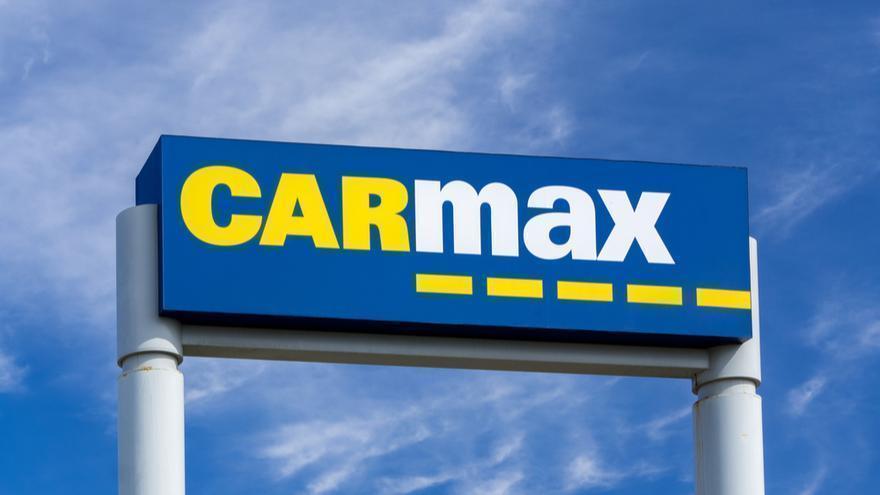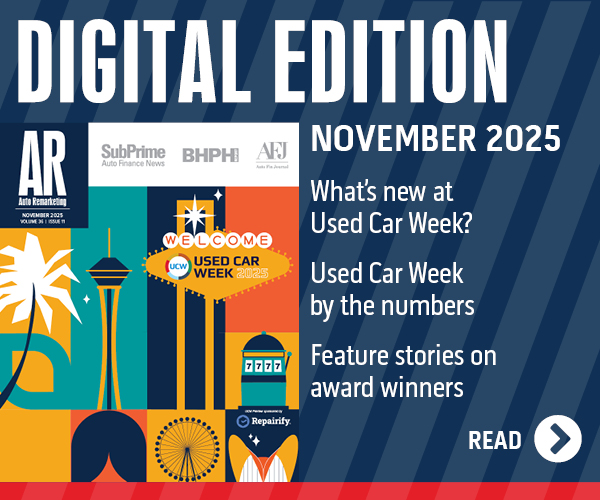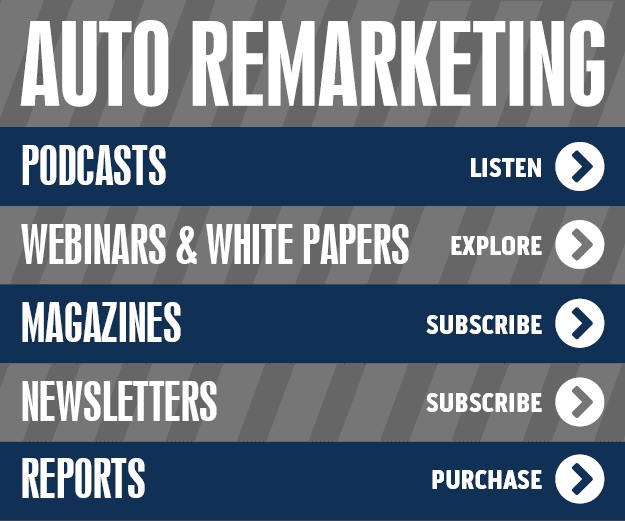CarMax thrives amid strong market for trade-in opportunities, used sales

Photo credit: Ken Wolter / Shutterstock.com.
By subscribing, you agree to receive communications from Auto Remarketing and our partners in accordance with our Privacy Policy. We may share your information with select partners and sponsors who may contact you about their products and services. You may unsubscribe at any time.
When consumers think used cars, many think of CarMax, the nation’s largest publicly traded used-car retailer. And there’s a good reason for that. The company’s reputation as a large-volume used-vehicle retailer shone strong during the company’s fiscal year 2022.
CarMax recently released its fourth quarter and full 2022 fiscal year results, and the company’s share of the nationwide age zero- to 10-year-old used-vehicle market increased to a record 4.0% in calendar year 2021. This was up from 3.5% in 2020.
And Bill Nash, president and chief executive officer of the used-vehicle giant, said during the company’s recent earnings call, “We are confident we will expand market share beyond 5% by 2025.”
The company’s share of the market brought in net revenues of $7.7 billion in the last quarter of its fiscal year 2022, up a whopping 48.8% from the same quarter the year past. This revenue came from sales of 343,414 used vehicles through CarMax’s retail and wholesale channels in Q4.
“We are extremely proud of our accomplishments in fiscal 2022, which we believe position us well for continued long-term growth across our retail and wholesale business and CarMax Auto Finance,” said Nash.
For the full year, CarMax sold more than a million (1,630,550) used vehicles, up 38.4% from the year prior. Retail sales made up 924,338 of these vehicles. This number did include a slight decline in used-retail sales during Q4, as outlined by Nash in the company’s earnings call, due to some pressure on sales at the end of the fiscal year.
Subscribe to Auto Remarketing to stay informed and stay ahead.
By subscribing, you agree to receive communications from Auto Remarketing and our partners in accordance with our Privacy Policy. We may share your information with select partners and sponsors who may contact you about their products and services. You may unsubscribe at any time.
CarMax leadership explained during the Q&A portion of the call that high gas prices didn’t make much of an impact on the types of vehicles sold. “Gas guzzler” sales were very similar year-over-year for CarMax.
“We’ve seen an uptick in EV searches, but we have certainly navigated that reform and have been very successful. If consumers want something different, we’re right there for them,” Nash said.
The company did see retail sales and interest shift to older vehicles as used-vehicle prices remained quite high. This also meant longer-term used-car loans. CarMax Auto Finance, the retailer's in-house financing arm, is currently not taking loans past 72 months, according to Jon Daniels, senior vice president of CarMax Auto Finance.
Nash said that sales shifted a bit from the zero- to 4-year-old vehicles to the 5- to 7-year market bucket.
“If we see customers searching for different types of inventory, we make sure we get that inventory out there,” said Nash.
As interest rates go up and inflation is increasing, along with the ongoing COVID pandemic and the conflict in Ukraine and Russia, “You’ve just got a lot weighing on consumers’ minds right now,” Nash said.
“As far as when that turns around, I don’t know, but we’re going to manage it. We’ve managed cycles like this before, and are in a position to manage it again,” he said.
When asked about how the tax season went for CarMax during the earnings call, company leadership said it’s very representative of what the company experienced the year before.
Last year was a late tax season, in terms of what the industry normally sees, CarMax leadership said.
“This year, timing wise was very similar to last year. I do think the refunds are a little bit higher this year versus last year … regardless of the tax season, the consumers aren’t as confident as they were a year ago,” said Nash.
Nash shared in December at the start of the fiscal quarter the company was happy with its used-sales performance.
“However, we began to see pressure after the holidays that continued through the end of the quarter,” he said, leading to a decline of 5.2% year-over-year during Q4.
The company says several macro-factors weighed on marketwide used-car sales, including lagging consumer confidence, vehicle affordability, the Omicron COVID variant surge, and more.
Amid a tight used inventory environment, CarMax turned in part to its clients to boost vehicle numbers, buying approximately 324,000 vehicles from consumers in Q4. This is up 69% year-over-year. Even more telling were the full-year results, as CarMax bought 95.5% more vehicles from consumers than in fiscal year 2021.
A driver of these purchases was the company’s online instant appraisal offering, allowing potential sellers to get appraisal offers instantly from the comfort of their own homes.
“The rollout and rapid adoption of our online instant appraisal offer has solidified our position as the nation’s largest buyer of vehicles from consumers, nearly doubling our fiscal 2022 inventory self- sufficiency and propelling our wholesale business to new heights,” Nash said in the press release announcing 2022 fiscal-year earnings.
And the company chose to pass along some of its self-sufficiency acquisitions cost earnings to consumers — via lower prices.
“We believe we struck a good balance between covering inflationary cost, maintaining profit margin and keeping our vehicles more affordable,” said Nash, during the recent call.
The company expects to make this appraisal capability available to 100% of its customers by the end of its Q1.
“Leveraging our online appraisal offering to buy a record number of cars directly from consumers enabled us to nearly double our self-sufficiency, as well as drive sustainable wholesale unit growth,” Nash said.
Why is the offering so successful? Nash shared that one factor is the ease of use of the product, as well as the backing of the brand recognition of the CarMax brand.
“Let’s not forget. This is what we do; we’ve been buying cars from consumers since 1993,” said Nash.
The company is also actively advertising for its online appraisal tool.
“If I look at the fourth quarter and think about our advertising spend, we break it down between brand awareness and acquisition awareness,” said Nash. “We spent a little bit more on acquisition awareness this past quarter than we have in previous quarters, so we feel good about the advertising.”
As far as competition goes in this area of the business, CarMax leadership explained everyone is benefiting from higher used valuations, and the company is looking to continue innovating to stay ahead of the game.
“We are going to continue to improve on that (digital appraisal) experience for our consumers, but we’ve also been testing and will continue to roll this out to make it available to other dealers as an easy way to get rid of inventory, and look for other partnerships where we can leverage this.”
Touching further on CarMax’s online and e-commerce capabilities, leaders explained the company’s ability to offer “seamless integration” across physical and digital transactions gives the company access to the largest total addressable markets.
Nash said, “This is a key differentiator and one that will continue to enhance.”
During Q4 of the company’s past physical year, 11% of used retail sales were online, up year-over-year from 5%.
CarMax’ wholesale auctions remain virtual after the change was made to adjust to life during the COVID pandemic. Consequently, 100% of the company’s wholesale customers completed their transactions online.
“Going forward we will continue to grow our online capabilities to enable more seamless experiences for our associates and customers,” Nash said.
The company’s gross profit per retail used unit in Q4 and full fiscal year results illustrated another overarching industry trend — soaring used-vehicle prices.
Gross profit per retail used vehicle came in at $2,195 in Q4 and $2,205 for full-year, up $109 and $92, respectively. Wholesale prices were also up, as well, making acquiring quality used vehicles challenging for dealerships across the country.
An interesting question posed during the earnings call revolved around the future equity situation for customers and their used cars.
Consumers are currently sitting on a lot of positive equity in their cars. Prices are high, making it a more positive environment for trade-ins and purchases direct from the consumer. But what happens when the market normalizes, and negative equity returns?
“For some customers it may be harder for them, because they can’t come up with a big enough down payment. But again, the way I think about it, if you look at loan-to-value, it’s actually going down,” said Nash. “People are putting more down payments down, so that’s a good sign.”
The other trend he pointed out is that customers buying today won’t all decide to trade in a year from now, or two to three years down the road.
“They are going to be sprinkled throughout time, and we’ll manage the business just like we have in the past with other customers that have equity,” he said.
CarMax was also busy this past year opening new points of retail for its customers. The dealer group opened four new retail locations in Q4 and 10 new locations when looking at the full fiscal year. This means CarMax now has a total of 230 used-car stores in the U.S. And the company isn’t slowing down when it comes to growth. In fiscal 2023, the company aims to open another 10 stores — and this includes its first entry into the New York metro market.
Adding physical stores to its lineup isn’t the only growth the company is positioned for. CarMax leaders expressed last spring that the company is aiming to surpass sales of 2 million vehicles through retail and wholesale channels by fiscal year 2026.
As far as men and women employed by the company to fill these stores and make these sales, Nash feels good about both the company’s production capacity and staffing at this point.
During the first through third quarters of this past fiscal year, Nash said he had talked a lot about getting staff ramped up — and the efforts seem to have paid off. He was also concerned about low inventory, but that trend seems to have evened out, as well.
“We're not quite at the 320 (vehicles) per store that’s desired, but I would tell you it wasn’t a big story — I do feel like we’ve got the capacity we need,” Nash said. “I think we are well positioned for however the market is going forth, due in part to the companies’ diversified business and more.”


